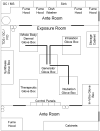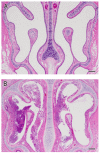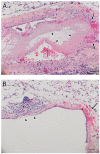Inhalation exposure systems for the development of rodent models of sulfur mustard-induced pulmonary injury
- PMID: 20025432
- PMCID: PMC3154732
- DOI: 10.3109/15376510903483730
Inhalation exposure systems for the development of rodent models of sulfur mustard-induced pulmonary injury
Abstract
Sulfur mustard (SM) is a chemical threat agent for which its effects have no current treatment. Due to the ease of synthesis and dispersal of this material, the need to develop therapeutics is evident. The present manuscript details the techniques used to develop SM laboratory exposure systems for the development of animal models of pulmonary injury. These models are critical for evaluating SM injury and developing therapeutics against that injury. Iterative trials were conducted to optimize a lung injury model. The resulting pathology was used as a guide, with a goal of effecting homogeneous and diffuse lung injury comparable to that of human injury. Inhalation exposures were conducted by either nose-only inhalation or intubated inhalation. The exposures were conducted to either directly vaporized SM or SM that was nebulized from an ethanol solution. Inhalation of SM by nose-only inhalation resulted in severe nasal epithelial degeneration and minimal lung injury. The reactivity of SM did not permit it to transit past the upper airways to promote lower airway injury. Intratracheal inhalation of SM vapors at a concentration of 5400 mg x min/m(3) resulted in homogeneous lung injury with no nasal degeneration.
Figures










Similar articles
-
Editor's Highlight: Pulmonary Vascular Thrombosis in Rats Exposed to Inhaled Sulfur Mustard.Toxicol Sci. 2017 Oct 1;159(2):461-469. doi: 10.1093/toxsci/kfx151. Toxicol Sci. 2017. PMID: 28962529 Free PMC article.
-
Evaluation of protease inhibitors and an antioxidant for treatment of sulfur mustard-induced toxic lung injury.Toxicology. 2009 Sep 1;263(1):41-6. doi: 10.1016/j.tox.2008.08.025. Epub 2008 Sep 21. Toxicology. 2009. PMID: 18852015
-
Dermal and ocular exposure systems for the development of models of sulfur mustard-induced injury.Toxicol Mech Methods. 2011 Sep;21(7):547-53. doi: 10.3109/15376516.2011.569774. Epub 2011 Apr 8. Toxicol Mech Methods. 2011. PMID: 21473735
-
Research models of sulfur mustard- and nitrogen mustard-induced ocular injuries and potential therapeutics.Exp Eye Res. 2022 Oct;223:109209. doi: 10.1016/j.exer.2022.109209. Epub 2022 Aug 9. Exp Eye Res. 2022. PMID: 35961426 Review.
-
Potential Utility of N-acetylcysteine for Treating Mustard Lung.Crit Rev Eukaryot Gene Expr. 2017;27(3):247-266. doi: 10.1615/CritRevEukaryotGeneExpr.2017019740. Crit Rev Eukaryot Gene Expr. 2017. PMID: 29199610 Review.
Cited by
-
Functional and inflammatory alterations in the lung following exposure of rats to nitrogen mustard.Toxicol Appl Pharmacol. 2011 Jan 1;250(1):10-8. doi: 10.1016/j.taap.2010.09.016. Epub 2010 Sep 29. Toxicol Appl Pharmacol. 2011. PMID: 20883710 Free PMC article.
-
Recognizing occupational effects of diacetyl: What can we learn from this history?Toxicology. 2017 Aug 1;388:48-54. doi: 10.1016/j.tox.2016.06.009. Epub 2016 Jun 17. Toxicology. 2017. PMID: 27326900 Free PMC article.
-
Progressive Lung Injury, Inflammation, and Fibrosis in Rats Following Inhalation of Sulfur Mustard.Toxicol Sci. 2020 Dec 1;178(2):358-374. doi: 10.1093/toxsci/kfaa150. Toxicol Sci. 2020. PMID: 33002157 Free PMC article.
-
Risks of on-pump coronary artery bypass grafting surgery in patients with chronic obstructive pulmonary disease due to sulfur mustard.Postepy Dermatol Alergol. 2017 Oct;34(5):429-432. doi: 10.5114/ada.2017.71107. Epub 2017 Oct 31. Postepy Dermatol Alergol. 2017. PMID: 29507556 Free PMC article. Review.
-
Editor's Highlight: Pulmonary Vascular Thrombosis in Rats Exposed to Inhaled Sulfur Mustard.Toxicol Sci. 2017 Oct 1;159(2):461-469. doi: 10.1093/toxsci/kfx151. Toxicol Sci. 2017. PMID: 28962529 Free PMC article.
References
-
- Afshinniaz F, Ghanei M. Relationship of the chronic respiratory symptoms with spirometric and laboratory parameters (Dissertation) Isfahan University of Medical Sciences; Isfahan, Iran: 1995.
-
- Anderson DR, Yourick JJ, Moeller RB, Petralim JP, Young GD. Pathologic changes in rat lungs following acute sulfur mustard inhalation. Inhal. Toxicol. 1996;8:285–297.
-
- Anslow WP, Houk CR. Chemical Warfare Agents and Related Chemical Problems. National Defense Research Committee; Washington DC, USA: 1946. Systemic pharmacology and pathology of sulfur mustard and nitrogen mustards; pp. 440–478.
-
- Aslani J. Late respiratory complications of sulphur mustard. In: Cheraghali AM, editor. Prevention and Treatment of Complications of Chemical Warfare Agents. Chemical Warfare Research Centre; Tehran, Iran: 2000. pp. 76–79.
-
- Balali-Mood M. First report of delayed toxic effects of Yperite poisoning in Iranian fighters. In: Heyndrickx B, editor. Proceedings of the Second World Congress on New Compounds in Biological and Chemical Warfare. Rijksuniversiteit; Ghent, Belgium: 1986. pp. 489–495.
Publication types
MeSH terms
Substances
Grants and funding
LinkOut - more resources
Full Text Sources
Other Literature Sources
Medical
Miscellaneous
